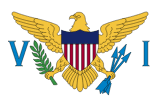Virgin Islands

About Virgin Islands
The Virgin Islands (Spanish: Islas Vírgenes) are an archipelago in the Caribbean Sea. They are geologically and biogeographically the easternmost part of the Greater Antilles, the northern islands belonging to the Puerto Rico Trench and St. Croix being a displaced part of the same geologic structure. Politically, the British Virgin Islands have been governed as the western island group of the Leeward Islands, which are the northern part of the Lesser Antilles, and form the border between the Caribbean Sea and the Atlantic Ocean. The archipelago is separated from the true Lesser Antilles by the Anegada Passage and from the main island of Puerto Rico by the Virgin Passage.
The islands fall into three different political jurisdictions:
British Virgin Islands, a British overseas territory,
United States Virgin Islands, an unincorporated territory of the United States,
Spanish Virgin Islands, the easternmost islands of the Commonwealth of Puerto Rico, itself an unincorporated territory of the United States.
Charlotte Amalie
Charlotte Amalie, located on St. Thomas, is the capital and the largest city of the United States Virgin Islands, founded in 1666 as Taphus (meaning "beer house" or "beer hall"). In 1691, the town was renamed to Charlotte Amalie after Charlotte Amalie of Hesse-Kassel (1650–1714), queen consort to King Christian V of Denmark-Norway. It has a deep-water harbor that was once a haven for pirates and is now one of the busiest ports of call for cruise ships in the Caribbean, with about 1.5 million/plus cruise ship passengers landing there annually. Protected by Hassel Island, the harbor has docking and fueling facilities, machine shops, and shipyards and was a U.S. submarine base until 1966. The Town has been inhabited for centuries. When Christopher Columbus arrived in 1493, the area was inhabited by Caribs, Arawaks, Ciboney and Taíno native peoples. It is on the southern shore at the head of Saint Thomas Harbor. In 2010 the City had a population of 18,481, which makes it the largest city in the Virgin Islands Archipelago. Hundreds of ferries and yachts pass by the Town each week.
The City is known for its Danish colonial architecture, building structure and history. Dozens of streets and places throughout the City have Danish names. Charlotte Amalie has buildings of historical importance including St. Thomas Synagogue, the second oldest synagogue in the United States, and Frederick Lutheran Church. The Town has a long history of pirates, especially myths of Bluebeard, and facts and stories of Blackbeard (Edward Teach). In the 17th century, the Danes built both Blackbeard's Castle and Bluebeard's Castle attributed to the pirates. Blackbeard's Castle is a U.S. National Historic Landmark. Another tourist attraction is Fort Christian, the oldest standing structure in the Virgin Islands Archipelago. A copy of the Liberty Bell and freed slave blowing a conch shell are in Emancipation Park, which is both a source of national pride and a tourist attraction.